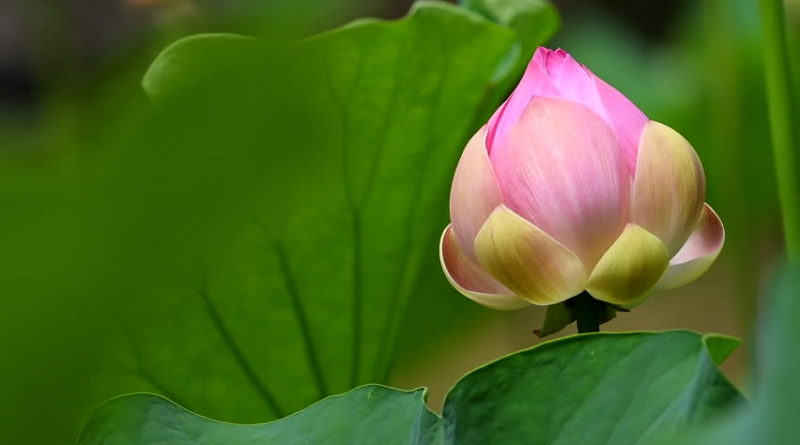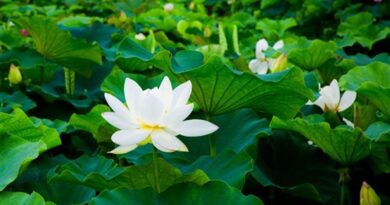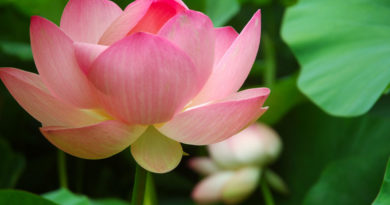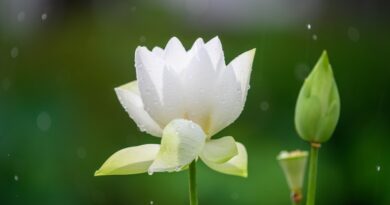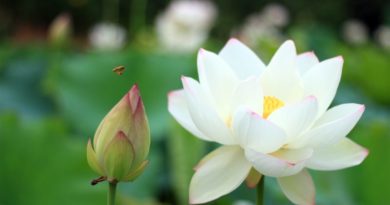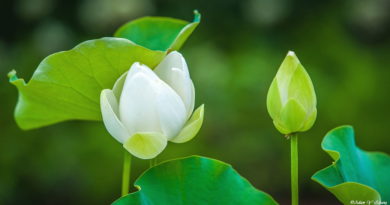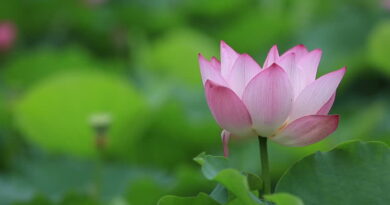ABHIDHAMMA IN DAILY LIFE – CHAPTER 8: AHETUKA CITTAS
If we want to know ourselves we should not merely know the moments we have akusala cittas or kusala cittas but other moments as well. When we see something ugly, we dislike what we see. At the moment of dislike there is akusala citta rooted in dosa (aversion). Before there is dislike, however, there must be moments of merely seeing the object. At these moments there are not yet akusala cittas, but cittas which are without ‘root’ (in Pali: hetu).
There are six cetasikas which are hetu or ‘root’. Three of these hetus are akusala; they are : lobha (attachment), dosa (aversion) and moha (ignorance). Three hetus are sobhana (beautiful); they are: alobha (greedlessness or generosity), adosa (non-hate or lovingkindness) and amoha (panna or wisdom). The citta or cetasika which is accompanied by a hetu is sahetuka. For example, dosa-mula-citta is sahetuka; moha and dosa are the hetus which arise with dosa-mula-citta.
Cittas without hetu are ahetuka cittas. There are many ahetuka cittas arising in a day. Whenever we see, hear, smell, taste or receive impressions through the body-sense, there are ahetuka cittas before cittas with hetu (wholesome cittas or unwholesome cittas) arise. We are inclined to pay attention only to the moments of like and dislike, but we should know other moments as well; we should know ahetuka cittas.
There are altogether eighteen types of ahetuka citta. Fifteen types of ahetuka citta are vipakacittas and three types are kiriyacittas (cittas which are ‘inoperative’, neither cause nor result). Seven of the ahetuka vipakacittas are akusala vipakacittas (result of unwholesome deeds) and eight of them are kusala
vipakacittas (result of wholesome deeds). When an unpleasant object impinges on the eye-sense, seeing-consciousness only experiences what appears through the eyes; there is no dislike yet of the unpleasant object. Seeing-consciousness is an ahetuka vipakacitta. Cittas which dislike the object arise later on; these are seen. The citta which pays attention to the shape and form of something and knows what it is, does not experience an object through the eye-door but through the mind-door; it has a different characteristic. When one uses the word ‘seeing’ one usually means: paying attention to the shape and form of something and knowing what it is, but there must also be a kind of citta which merely sees visible object, and this citta does not know anything else. What we see we can call ‘visible object’ or ‘colour’ ; what is meant is: what appears through the eyes. When there is hearing, we can experience that hearing has a characteristic which is different from seeing; the citta which hears experiences sound through the ears. Only in experiencing the different characteristics of realities over and over again, will we come to know them as they are. People may think that there is a self which can see and hear at the same time, but through which door can the self be experienced? Taking realities for self is wrong view.
Seeing, hearing, smelling, tasting and receiving impressions through the body-sense do not arise without there being conditions for their arising; they are the result of kamma. Eye-sense, ear-sense, smelling-sense, tasting- sense and body-sense are rupas which are produced by kamma as well; they are the corporal result of kamma. Only the mental result of kamma is called vipaka, and thus only citta and cetasika (mental factors arising with the citta) can be vipaka. Rupa is not vipaka.
The Buddha taught that everything which arises must have conditions for its arising. When we see something unpleasant there must be a condition for it: it is the result of akusala kamma. Akusala vipaka cannot be the result of kusala kamma. Seeing something pleasant is kusala vipaka; this can only be the result of kusala kamma. The vipakacitta which arises when there is an unpleasant or pleasant impression through one of the five senses is ahetuka. At that moment there are no akusala hetus (unwholesome roots) or sobhana hetus (beautiful roots) arising with the citta.
The ahetuka vipakacitta which sees an unpleasant or a pleasant object through the eyes is seeing- consciousness, in Pali: cakkhu-vinnana (cakkhu means eye).
The ahetuka vipakacitta which hears an unpleasant or a pleasant object through the ears is hearing- consciousness, in Pali: sota-vinnana (sota means ear).
The ahetuka vipakacitta which smells an unpleasant or a pleasant object through the nose is smelling-consciousness, in Pali: ghana-vinnana (ghana means nose).
The ahetuka vipakacitta which experiences an unpleasant or a pleasant taste through the tongue is tasting- consciousness, in Pali: jivha-vinnana (jivha means tongue).
The ahetuka vipakacitta which experiences an unpleasant or a pleasant object through the body-sense is body-consciousness, in Pali: kaya-vinnana (kaya means body) .
There are two kinds of ahetuka vipaka experiencing an object through each of the five doors: one is akusala vipaka and one is kusala vipaka. Thus there are five pairs of ahetuka vipakacittas which arise depending on the five sense-doors. There are also other kinds of ahetuka vipakacitta which will be dealt with later on. The ten ahetuka vipakacittas which are the ‘five pairs’ are called in Pali: dvi-panca-vinnana (two times five vinnana). They are:
- Cakkhu-vinnana (seeing-consciousness):
– akusala vipaka, accompanied by upekkha (indifferent feeling)
-kusala vipaka, accompanied by upekkha - Sota-vinnana (hearing-consciousness):
– akusala vipaka, accompanied by upekkha
– kusala vipaka, accompanied by upekkha - Ghana-vinnana (smelling-consciousness):
– akusala vipaka, accompanied by upekkha
– kusala vipaka, accompanied by upekkha - Jivha-vinnana (tasting-consciousness):
– akusala vipaka, accompanied by upekkha
– kusala vipaka, accompanied by upekkha - Kaya-vinnana (body-consciousness):
– akusala vipaka, accompanied by dukkha vedana (bodily painful feeling)
– kusala vipaka, accompanied by sukha vedana (bodily pleasant feeling)
The ahetuka vipakacittas which see, hear, smell and taste are invariably accompanied by upekkha (indifferent feeling), no matter whether they are akusala vipaka or kusala vipaka. The citta which dislikes the object may arise afterwards. This citta is sahetuka (with hetus or roots) and it is accompanied by unpleasant feeling. Or the citta which likes the object may arise; this citta which is also sahetuka may be accompanied by pleasant feeling or by indifferent feeling. We are inclined to think that the dvi-panca-vinnanas can occur at the same time as like or dislike of the object, but this is not so. Different cittas arise at different moments and the feelings which accompany the cittas are different too; none of these realities should be taken for self.
The feeling arising with the body-consciousness which experiences an impression through the body-sense cannot be indifferent; it arises either with bodily painful feeling or with bodily pleasant feeling. When an unpleasant bodily impression is experienced the feeling which accompanies the body-consciousness is dukkha-vedana (bodily painful feeling). When a pleasant bodily impression is experienced the feeling which accompanies the body-consciousness is sukha-vedana (bodily pleasant feeling). Bodily unpleasant feeling and bodily pleasant feeling are nama which can arise only with the body-consciousness which experiences an object through the body-sense. Both bodily feeling and mental feeling are nama, but they arise because of different conditions and at different moments. For example, we may have bodily pleasant feeling when we are in comfortable surroundings, but in spite of that, we may still be worried and also have moments of mental unpleasant feeling; these feelings arise at different moments. Bodily pleasant feeling is the result of kusala kamma. The mental unpleasant feeling which arises when we are unhappy is conditioned by our accumulation of dosa (aversion) ; it is akusala.
The whole day there are impressions received through the body-sense, which is a kind of rupa. Bodily impressions can be received all over the body and thus the door of the body-sense can be at any place of the body. Whenever we touch hard or soft objects, when cold or heat contacts the body, and when we move, bend or stretch, there are unpleasant or pleasant impressions received through the body-sense. One may wonder whether at each moment there is a bodily impression, bodily pleasant or bodily unpleasant feeling arises. One may notice the coarse bodily feelings, but not the subtle bodily feelings. For example, when something is a little too hard, too cold or too hot, there is dukkha-vedana (bodily painful feeling) arising with the body consciousness which experiences the object through the body-sense. One may not notice the subtle bodily feelings if one has not learned to be aware of realities.
The arahat, when he experiences an unpleasant impression or a pleasant impression through the body-sense, only has bodily unpleasant feeling or bodily pleasant feeling arising with the body-consciousness. He has no akusala cittas or kusala cittas after the vipakacitta; he has kiriyacittas (‘inoperative’ cittas: The deeds which the arahat performs are neither kusala nor akusala. So he will not be born again.). We read in the ‘Kindred Sayings’ (IV, Salayatana-vagga, Kindred Sayings about Feeling, Book I, par.6) that the Buddha said to the monks:
‘The untaught manyfolk, monks, feels feeling that is pleasant, feeling that is painful and feeling that is neutral. The well-taught Ariyan disciple, monks, feels the same three feelings. ‘
Now herein, monks, what is the distinction, what is the specific feature, what is the difference between the well-taught Ariyan disciple and the untaught manyfolk?’
‘For us, lord, things are rooted in the Exalted One….’
‘The untaught manyfolk, monks, being touched by feeling that is painful, weeps and wails, cries
aloud, knocks the breast, falls into utter bewilderment. For he feels a twofold feeling, bodily and mental … Touched by that painful feeling he feels repugnance for it. Feeling that repugnance for the painful feeling, the lurking tendency to repugnance fastens on him. Touched by the painful feeling, he delights in pleasant feeling. Why so? The untaught manyfolk, monks, knows of no refuge from painful feeling save sensual pleasure. Delighting in that sensual pleasure, the lurking tendency to sensual pleasure fastens on him….’
Is this not real life? Touched by painful feeling, we delight in pleasant feeling; we believe that pleasant feeling is real happiness. we do not see life as it really is: dukkha. We wish to close our eyes to sickness, old age and death, to ‘lamentation and despair’, to the impermanence of all conditioned realities. We expect happiness in life and when we have to suffer we think that pleasant feeling might cure us of suffering and we cling to it. In the Buddha’s teaching of the ‘Dependent Origination’ it is said that feeling conditions craving. Not only pleasant feeling and indifferent feeling condition craving, also painful feeling conditions craving, since one wishes to be liberated from painful feeling. Furthermore we read in the sutta:
‘….If he feels feeling that is pleasant, he feels it as one in bondage. If he feels feeling that is painful, he feels it as one in bondage. If he feels feeling that i s neutral, he feels it as one in bondage. This untaught manyfolk, monks, is called ‘in bondage to birth, death,
sorrow and grief, woe, lamentation and despair. He is in bondage to dukkha. So I declare.
But, monks, the well-taught Ariyan disciple, when touched by painful feeling, weeps not, wails not, cries not aloud, knocks not the breast, falls not into utter bewilderment. He feels but one feeling, the bodily, not the mental… If he feels a feeling that is pleasant, he feels it as one freed from bondage. If he feels a feeling that is painful, he feels it as one that is freed from bondage. If he feels a neutral feeling, he feels it as one that is freed from bondage. This well-taught Ariyan
disciple, monks, is called ‘freed from the bondage of birth, old age, from sorrow and grief, from woe, lamentation and despair, freed from the bondage of dukkha.’ So I declare….’
Feelings arise because of conditions and fall away again. They are impermanent
and they should not be taken for self. We read in the ‘Kindred Savings’ (lV Salayatana-vagga, Kindred Sayings on Sense, Third Fifty, par. 130, Haliddaka):
Once the venerable Kaccana the Great was staying among the folk of Avanti, at Osprey’s Haunt, on a sheer mountain crag. Then the housefather Haliddakani came to the venerable Kaccana the Great. Seated at one side he said this:
‘lt has been said by the Exalted One, sir, “Owing to diversity in elements arises diversity of contact. Owing to diversity of contact arises diversity of feeling.” Pray, sir, how far is this so?’
‘Herein, housefather, seeing a pleasant object with the eye, a monk, at the thought “This is such
and such,” comes to know of eye-consciousness that is pleasant to experience. Owing to contact that is pleasant to experience arises pleasant feeling.
When with the eye he sees an object that is displeasing, a monk, at the thought “This is such and
such,” comes to know of eye-consciousness that is unpleasant to experience. Owing to contact that is unpleasant to experience arises unpleasant feeling.
When with the eye he sees an object that is of indifferent effect, a monk, at the thought “This is such and such,” comes to know of consciousness that is neutral. Owing to contact that is neutral to experience arises feeling that is neutral.
So also, housefather, hearing a sound with the ear, smelling a scent with the nose, tasting a savour with the tongue, contacting a tangible with the body, cognizing a pleasing mind-state with the mind… a mind-state that is displeasing… a mind-state that is indifferent in effect….
Thus, housefather, owing to diversity in elements arises diversity of contact. Owing to diversity of contact arises diversity of feeling.’
If we are mindful of realities which appear through the different doorways we will know from experience many different namas and rupas; we will know different types of citta and different kinds of feeling. We will know that all these realities are only conditioned elements and not self. We will know from experience that there are not only cittas accompanied by lobha, dosa and moha, and cittas accompanied by wholesome roots, but also cittas which are ahetuka, cittas without roots. One may not find it interesting to know more about seeing, hearing and the other realities appearing through the different doorways. However, in order to see things as they are, it is essential to know that the citta which, for example, experiences sound, has a characteristic which is different from the citta which likes or dislikes the sound and that these cittas arise because of different conditions. What the Buddha taught can be proved by being mindful of realities.
-ooOoo-
Questions
- Which are the six hetus (roots)?
2. When there is seeing it may be kusala vipaka or akusala vipaka. Are there hetus accompanying seeing-consciousness?
Source: Budsas.net

